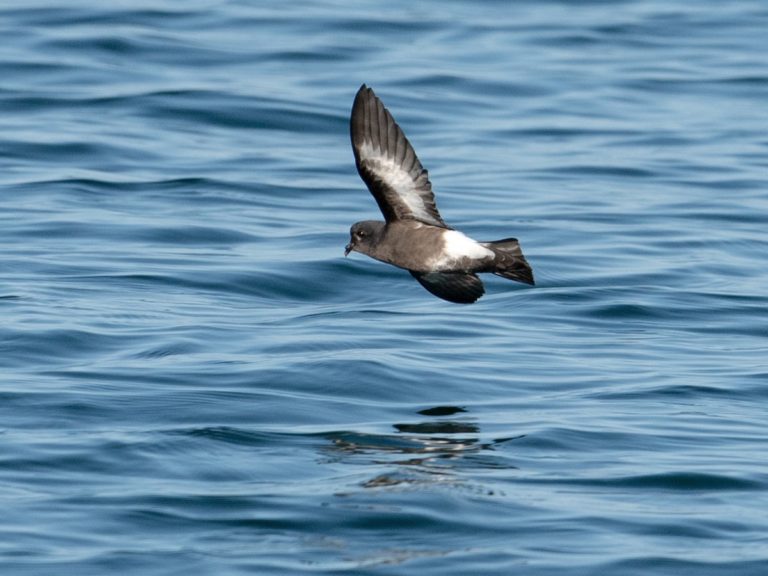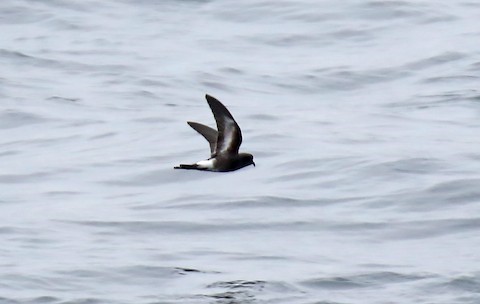Birdfinding.info ⇒ The newly described Pincoya Storm-Petrel is locally common in its limited known range in south-central Chile. It can often be found on boat trips from Puerto Montt into Reloncaví Sound, and in Chacao Strait from the ferry to Chiloé Island.
Pincoya Storm-Petrel
Oceanites pincoyae
Known mainly from south-coastal Chile; may breed inland in Argentina.
Appears to be largely resident in coastal waters of Reloncaví Sound, the Gulf of Ancud, and elsewhere around Chiloé Island. It has been reported north to the waters offshore from Concepción and south to the Gulf of Penas.
Formally recognized as a species in 2016, following research that began in 2009 with observations that Oceanites storm-petrels in Reloncaví Sound were peculiarly pale. Uncertainty remains about the taxonomic relationship between Pincoya and the “Fuegian Storm-Petrel”, which occurs throughout Chilean waters. The strong similarity between them complicates research into Pincoya’s status.
Circumstantial evidence suggests that it probably nests in the Andes east of its known range, likely in the vicinity of Lago Puelo in Chubut, Argentina—which lies about 100 km east of the Gulf of Ancud and connects to Reloncaví Sound via the Río Puelo and a chain of lakes. The earliest known specimens were collected around Lago Puelo, and additional sightings have been reported in the area.
Identification
A small storm-petrel that closely resembles the “Fuegian” (chilensis) form of Wilson’s Storm-Petrel, but typically shows more extensive white on the underwings, and more often has white that extends from the rump down to the lower belly.
Pincoya also tends to show broader white bars on the uppersides of its wings and white on its outer tail feathers. However, both Pincoya and “Fuegian” vary in all of these features enough that some individuals appear intermediate.

Pincoya Storm-Petrel, showing extensive white on the belly and underwings. (Offshore from Aysén Province, Chile; March 11, 2016.) © Fabrice Schmitt
Pincoya also resembles Elliot’s Storm-Petrel—both having some white on the belly—and the two could occur together in central Chilean waters. (See below for more details comparisons with “Fuegian” and Elliot’s Storm-Petrels.)
Like all other Oceanites storm-petrels, Pincoya is dark-brown overall, with an even white band across the rump that extends down the sides of the rump. The tail is shallowly notched, and often appears squarish, or rounded when fully fanned.

Pincoya Storm-Petrel, showing extensively white underwing and some white on the belly. (Gulf of Ancud, Los Lagos, Chile; February 22, 2020.) © Kirk Zufelt

Pincoya Storm-Petrel, showing somewhat less extensive white on underwing coverts. (Reloncaví Sound, Los Lagos, Chile; December 30, 2017.) © Jay Huila Balvin
The legs are long enough that the feet project beyond the tail-tip in flight. The feet have yellow webs, which are often visible when they feed—pattering their feet on the surface.
Like most other dark storm-petrels, Pincoya shows a whitish, blond, or pale-brown diagonal stripe on the secondary wing coverts.
Typical flight patterns include swallow-like gliding, interspersed with quick shallow wingbeats, and fluttering, which is usually associated with feeding, often holding its wings in a deep “V” and pattering its toes in the water.
Juveniles tend to show more extensive white than adults, often including pale patches on the face.

Pincoya Storm-Petrel, showing white highlights on the upperwing and on the outermost tail feathers. (Gulf of Ancud, Los Lagos, Chile; February 24, 2020.) © Kirk Zufelt
Notes
Monotypic species. As discussed below, it seems plausible that Pincoya is more accurately classified as a subspecies or localized variant of the “Fuegian” (chilensis) form of Wilson’s Storm-Petrel (oceanicus).
See below for comparisons of Pincoya Storm-Petrel with “Fuegian Storm-Petrel” and Elliot’s Storm-Petrel.
Cf. “Fuegian Storm-Petrel”. In south-central Chilean waters around Chiloé Island, “Fuegian” and Pincoya Storm-Petrels occur together. The main visual difference between them is that Pincoya has more extensive white on the underwing coverts, and more often has white that extends from the rump down to the lower belly. Pincoya also typically has more white on the upperwing coverts, but this difference is less pronounced.
Identification by sight is not always reliable, however, as both “Fuegian” and Pincoya show significant variation in the amount of white in all the key areas. Intensive research on the storm-petrels within Pincoya’s limited range has shown that the Pincoya population exhibits a spectrum of these characteristics, with some extensively white and some that approximately the same as the whitest “Fuegians”. (In similar fashion, “Fuegian” seems to show a spectrum from paler Pincoya-like plumage to darker individuals that are consistent with “Wilson’s”.)
While awaiting the development of more comprehensive field research on the breeding populations of Pincoya and “Fuegian”, it seems reasonable to conjecture that Pincoya and “Fuegian” might possibly be part of a single species, and that the typical pale Pincoya might be a localized color morph within a “Fuegian” population. Perhaps the strongest factor weighing against this conclusion is the Pincoya’s distinctive life history as a mostly coastal, localized resident form, in contrast to “Fuegian”, which is more pelagic and migrates to tropical latitudes during the austral winter. Taken together, Pincoya’s divergent plumage and life history seem justify classification as a separate subspecies and distinct form—if so, then the more difficult question is whether these differences are sufficient to maintain its current recognition as a separate species.
Cf. Elliot’s Storm-Petrel. Elliot’s and Pincoya Storm-Petrels share most visible features in common, including white on the belly, so they would be readily mistaken for one another if they occurred in the same areas. Elliot’s is largely tropical, with one form, “Lowe’s”, resident in the Galápagos and the other, “Elliot’s”, breeding in the Atacama Desert and resident along the coasts of Peru and northern Chile. Pincoya is largely resident in the cold temperate zone of south-central Chile. It is possible that they may overlap, at least occasionally, along the central Chilean coast.
Elliot’s and Pincoya both typically show white on the belly, but usually in different patterns. On Elliot’s the white is usually centered on the upper part of the belly, toward the middle of its underparts, whereas on Pincoya the white is centered on the lower belly, around the base of the legs. In most cases, Pincoya also differs in having more extensively white underwings, which is usually its most conspicuous feature. The Atacama-Desert-breeding “Elliot’s” is additionally somewhat smaller than both “Lowe’s” and “Fuegian”, although this difference seems too slight to be useful in field identification.
Additional Photos of Pincoya Storm-Petrel

Pincoya Storm-Petrel. (Reloncaví Sound, Los Lagos, Chile; December 30, 2017.) © Jay Huila Balvin

Pincoya Storm-Petrel. (Reloncaví Sound, Los Lagos, Chile; December 30, 2017.) © Jay Huila Balvin

Pincoya Storm-Petrel, showing limited white on underwing coverts—identification inferred from the location, as this individual appears consistent with “Fuegian Storm-Petrel”, O. o. chilensis. (Reloncaví Sound, Los Lagos, Chile; May 28, 2016.) © Cristian Pinto

Pincoya Storm-Petrel, showing extensive white on belly and underwings. (Chacao Strait, Los Lagos, Chile; February 8, 2010.) © Christian Nunes
References
BirdLife International. 2018. Oceanites pincoyae. The IUCN Red List of Threatened Species 2018: e.T45354823A132668660. https://dx.doi.org/10.2305/IUCN.UK.2018-2.RLTS.T45354823A132668660.en. (Accessed November 9, 2021.)
eBird. 2021. eBird: An online database of bird distribution and abundance. Cornell Lab of Ornithology, Ithaca, N.Y. http://www.ebird.org. (Accessed November 9, 2021.)
Howell, S.N.G., and F. Schmitt. 2016. Pincoya Storm Petrel: comments on identification and plumage variation. Dutch Birding 38:384-388.
Howell, S.N.G., and K. Zufelt. 2019. Oceanic Birds of the World. Princeton University Press.
Martínez Piña, D.E., and G.E. González Cifuentes. 2021. Field Guide to the Birds of Chile. Princeton University Press.
South American Classification Committee. 2016. Proposal 721: Treat Pincoya Storm-Petrel (Oceanites pincoyae) as a valid new species. https://www.museum.lsu.edu/~Remsen/SACCprop721.htm.

